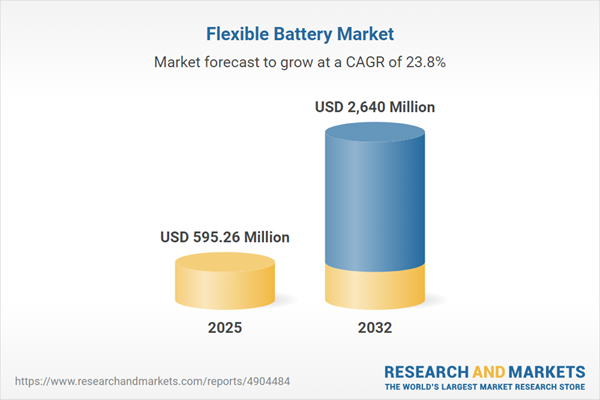Speak directly to the analyst to clarify any post sales queries you may have.
The Flexible Battery Market is undergoing rapid transformation driven by advancements in materials, evolving manufacturing capabilities, and heightened demand across next-generation electronics and industrial solutions. Flexible batteries are steadily emerging as a cornerstone technology in energy storage for connected and miniaturized applications.
Market Snapshot: Flexible Battery Market
The global Flexible Battery Market grew from USD 479.66 million in 2024 to USD 595.26 million in 2025. Projected to sustain a CAGR of 23.81%, the market is expected to reach USD 2.64 billion by 2032. This accelerated expansion highlights the sector’s pivotal role in powering the next wave of wearables, IoT devices, and medical applications for both consumer and enterprise sectors.
Scope & Segmentation
- Technology: Paper-Based Batteries, Polymer Batteries (Gel Polymer, Solid Polymer), Printed Batteries (Inkjet-Printed, Screen-Printed), Thin-Film Batteries (Inorganic Thin-Film, Organic Thin-Film)
- Application: IoT Devices, Medical Devices (Diagnostic Patches, Implantable Devices), Portable Electronics (Laptops, Smartphones, Tablets), Smart Cards, Wearable Electronics (Fitness Bands, Smart Textiles, Smart Watches)
- Form Factor: Film, Multi-Cell Pouch, Single-Cell Pouch, Sheet, Textile-Integrated
- End User: Automotive & Transportation (Electric Vehicles, Hybrid Vehicles), Consumer Electronics, Healthcare, Industrial
- Capacity Range: 100-1000 mAh, Below 100 mAh, Over 1000 mAh
- Regions: Americas (North America: United States, Canada, Mexico; Latin America: Brazil, Argentina, Chile, Colombia, Peru), Europe, Middle East & Africa (Europe: United Kingdom, Germany, France, Russia, Italy, Spain, Netherlands, Sweden, Poland, Switzerland; Middle East: United Arab Emirates, Saudi Arabia, Qatar, Turkey, Israel; Africa: South Africa, Nigeria, Egypt, Kenya), Asia-Pacific (China, India, Japan, Australia, South Korea, Indonesia, Thailand, Malaysia, Singapore, Taiwan)
- Leading Companies: Ambri Incorporated, Apple Inc, Ateios Inc., Blue Spark Technology, Inc., BrightVolt Technologies, Coreshell Technologies, Cymbet Corporation, Energy Diagnostics Limited, Enfucell Oy, Huntsman International LLC, Ilika PLC, Imprint Energy Inc, ITEN SA, Jenax Inc.
Key Takeaways for Senior Decision-Makers
- The Flexible Battery Market is experiencing a surge in demand as organizations seek energy storage solutions that enable thin, lightweight, and bendable product designs for emerging devices.
- Strategic alliances between OEMs, material suppliers, and research institutions are accelerating time-to-market and supporting supply chain resilience amid evolving global trade and regulatory requirements.
- Environmental sustainability is a critical driver, with companies increasingly adopting recyclable substrates and non-toxic chemistries to align with circular economy goals and comply with regional mandates.
- Differentiated technology platforms, from solid polymer to organic thin-films, allow customization for unique use cases such as medical wearables and secure authentication devices.
- Flexible battery manufacturers are investing in modular and smart manufacturing, leveraging digital twins and process automation to scale production efficiently while ensuring performance consistency.
- Segment relevance varies by geography, with regions such as North America focusing on R&D and vertical integration, Europe emphasizing eco-friendly solutions, and Asia-Pacific driving large-scale, cost-efficient manufacturing.
Tariff Impact & Regulatory Shifts
New tariff policies in the United States, effective 2025, have altered global cost structures and supply chain logistics for flexible battery components. Market participants are strategically shifting toward domestic sourcing and forming long-term supplier agreements to offset price fluctuations and minimize disruption. These shifts are not only influencing procurement strategies but also providing innovation incentives, prompting investment in local pilot lines, advanced manufacturing, and collaborative ecosystems within the US market.
Methodology & Data Sources
This analysis is built on a multi-source research framework, integrating a comprehensive review of secondary literature, patent databases, regulatory materials, and primary interviews with technology developers, OEMs, suppliers, and regulators. Quantitative and qualitative data are synthesized using analytical modeling, scenario testing, and cross-validation, ensuring the accuracy and relevance of insights for flexible battery market stakeholders.
Why This Report Matters
- Facilitates informed strategic planning by providing clarity on market drivers, competitive dynamics, and technology trends crucial to flexible battery adoption.
- Arms decision-makers with actionable segmentation intelligence and regional market analysis, supporting tailored go-to-market and R&D investments.
- Delivers reliable, multi-source-backed insights into emerging developments, regulatory considerations, and alliance strategies shaping tomorrow’s energy storage landscape.
Conclusion
As flexible battery technology matures, successful market players will prioritize collaborative innovation, agile manufacturing, and proactive regulatory engagement. Leveraging these pillars will be critical in meeting the diverse demands of the evolving global energy storage market.
Additional Product Information:
- Purchase of this report includes 1 year online access with quarterly updates.
- This report can be updated on request. Please contact our Customer Experience team using the Ask a Question widget on our website.
Table of Contents
3. Executive Summary
4. Market Overview
7. Cumulative Impact of Artificial Intelligence 2025
Companies Mentioned
The companies profiled in this Flexible Battery market report include:- Ambri Incorporated
- Apple Inc
- Ateios Inc.
- Blue Spark Technology, Inc.
- BrightVolt Technologies
- Coreshell Technologies
- Cymbet Corporation
- Energy Diagnostics Limited
- Enfucell Oy
- Huntsman International LLC
- Ilika PLC
- Imprint Energy Inc
- ITEN SA
- Jenax Inc.
Table Information
| Report Attribute | Details |
|---|---|
| No. of Pages | 195 |
| Published | November 2025 |
| Forecast Period | 2025 - 2032 |
| Estimated Market Value ( USD | $ 595.26 Million |
| Forecasted Market Value ( USD | $ 2640 Million |
| Compound Annual Growth Rate | 23.8% |
| Regions Covered | Global |
| No. of Companies Mentioned | 15 |









